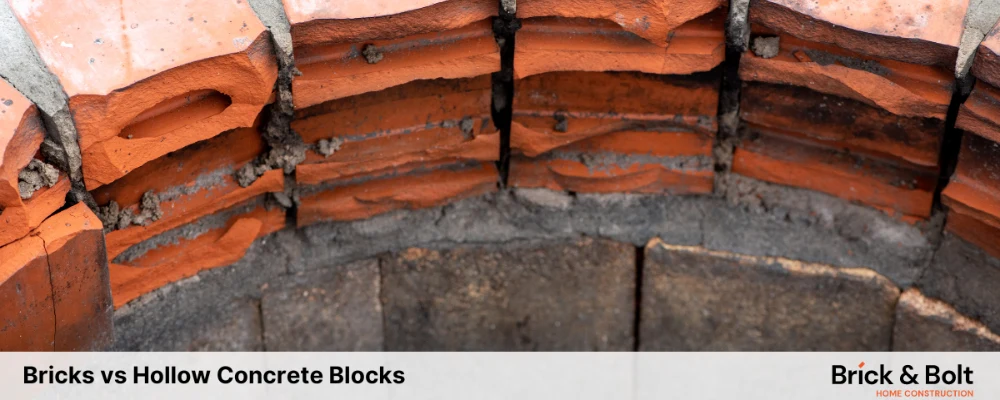Materials are very important when constructing a house or any other structure. Bricks and hollow concrete blocks are the most commonly used materials in the construction of walls, especially for residences. A common question among property owners is- which is the better material: bricks or hollow blocks? Let’s evaluate the differences between them, like costs, strength, insulation, and usability, so that you can make an informed choice for your construction project.
What are Bricks and Hollow Concrete Blocks?
Generally, bricks used are made from clay. The clay is moulded into cuboidal shapes, and these shapes are further heated at very high temperatures using a kiln. This tightens the clay and makes it strong. Bricks are said to be solid, which means they have no empty voids in them.
Hollow Concrete Blocks: These blocks are made of cement, sand, and small stones. Unlike bricks, these blocks have voids in them, thus making them lighter. The size of the hollow blocks is bigger than bricks, but they are rather easy to handle due to their lower weight.
Strength and Durability
Bricks: Bricks are highly durable and can last for a large number of years.. For this reason, bricks have been used in making homes from time immemorial. They are really tough and can bear loads in bulk without breaking.
Hollow Concrete Blocks: These are hard and strong, but not as much as bricks. They can be made stronger by putting steel bars inside or filling up the void space with concrete.
Thermal Insulation
Bricks: Due to their high density, a building made of bricks can retain warmth in winter and maintain coolness in the house in the summer. Day warmth is absorbed and then slowly released back by bricks during the night, helping keep days cool and nights warmer.
Hollow Concrete Blocks: Hollow concrete blocks have better thermal insulation than bricks. The hollow parts in the blocks trap the air in them, which keeps the building cool in the hot season. They can also prevent the escape of hot air by trapping it in their voids, thus keeping indoor spaces warm in winters.
Cost
Normally, bricks tend to be more costly than hollow blocks. This is attributed to them being usually more cumbersome and costly to produce. They are also small in size, meaning you need a larger number of bricks and more labour time for the construction of a wall.
Hollow concrete block walls are cheaper than brick walls by 15-20%. This is due to the mere fact that they are big, hence many hollow blocks would only entail less of the material in putting up the same size wall and also reduced time.
Workability
Bricks are smaller and heavier, so lots of them are required, making it time-consuming to lay a brick wall.
Hollow Concrete Block walls are quickly constructed because the blocks are large and light. They are also easier to handle and work with in general. However, cutting them into smaller pieces for laying is extremely difficult.
Environmental Impact
Bricks: Brick manufacture can negatively impact the environment.. The baking of bricks inside the kilns is energy-intensive and results in pollution. In making bricks, clay has to be dug up, which means that land is at risk.
Hollow Concrete Blocks: These types are more eco-friendly compared to the others, as they use less material. Some of these hollow blocks are made using recycled material. However, concrete in general is not considered to be sustainable due to the harmful manufacturing process of cement. .
Visual Appearance
Bricks: They are available in earthen colours and can be used to enhance the natural and traditional aesthetics of built forms when left exposed..
Hollow Blocks: In general, hollow blocks are grey in colour and do not have the great appearance that bricks have. Usually, they are plastered over or painted, which means that once the finished product is obtained, you do not see them.
Water Resistance
Brick walls, especially when left exposed, can be porous and develop mould. Few other problems that can be associated with these are seepage and also a white salt stain seen over them. This can be easily avoided using the various waterproof materials that are applied on bricks.
Hollow Concrete Blocks: They absorb very little water, and therefore, they are less sensitive to moisture, which makes them suitable for wet areas. They are less susceptible to seepage.
Conclusion
Both bricks and hollow concrete blocks are good building units for construction. Bricks are strong and long-lasting, having an aesthetic appearance, but they are more expensive and relatively more time-consuming to build with. Hollow blocks are cheap, easily used, and more environment-friendly, but they have reduced strength and flexibility in design. Thus, both materials have different properties, advantages and disadvantages, which must be carefully studied and evaluated before selection for individual project requirements.
FAQs:
Bricks are generally stronger than hollow blocks, but hollow blocks can be made stronger with reinforcement.
Yes, hollow blocks are usually cheaper because they use less material and are quicker to build with.
Hollow concrete blocks are better as they have higher thermal insulation.

